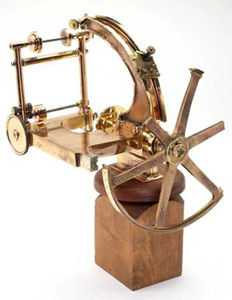Question from Heidi T.:
Hello Invention Geek,
In what state have the most patents been issued?
Heidi T.

Category: Patent Information
Question from Warren C.:
Hello Invention Geek,
Is there a process similar to eminent domain that can be excercised by the government to take ownership of a patent or take away exclusive rights by the inventor if the invention is deemed either something valuable for public safety like smoke alarms or something as dangerous as the atomic bomb for example?
Warren C.
Question from Simon T.:
What is a poor man’s patent?
Simon T.
Question from Devin D.:
Hello Geek,
Is it true that Harley-Davidson has a trademark for the sound of its engine?
Devin
Question from Ize:
How are fonts protected?
Thanks, Ize
If certain conditions are met, an individual who creates a font has limited options in protecting their typeface. Copyright and trademark laws provide minimal or no protection against typeface piracy. The extent of protection a typeface should receive has been debated about between The U.S Copyright Office and type designers since the 1970s. Design patents are the best option if you want to protect your typeface.
Conditions to receive a design patent:
- The font is not known or accessible to the public for more than one year prior to filing a design patent application.
- The typeface was not described or used in a printed publication in any country during the year prior to filing the application.
- The font design must be new. Meaning, it can not be an obvious variation of another design.
- The typeface isn’t registered as a design patent or industrial design in a foreign country.
In part one of this series, we talked about utility patents and how they are the oldest and most common in the United States. American inventors have been able to patent their new, functional ideas and objects since 1790.
Now, if utility patents require an object to have some unique and different functionality, what do you do when you want to protect the distinctly unique ornamentation of your functional product?
…you apply for a design patent, of course!
Design Patents Offer Protection for the Uniquely Ornate
Administered By: USPTO
Available Since: August 29, 1842
Annual Applications: 30,467 (in 2011, a new record)
Total Patents Granted: 635,355 (as of April 2011) Continue reading “Design Patents: Form Over Function”
Question from Suzie Q.:
Hello Geek!
I’ve heard that the “Happy Birthday” Song is patented. Is this true? If so, what’s the background info on this?
-Suzie Q.
As a song, “Happy Birthday to You” is not eligible for a patent but it is copyright material which means that royalties should be paid every time the song is sang in public.
The melody of “Happy Birthday to You” is from a song written by two sisters, Patty and Mildred J. Hil in 1893 titled “Good Morning to All.” The song was published as part of the book Song Stories for the Kindergarten with the lyrcis:
Good morning to you,
Good morning to you,
Good morning, dear children,
Good morning to all.
No one knows exactly when the lyrics of the song were adapted to Happy Birthday to You but the song first showed up in print in 1912. Between then and 1934, the songs was published in various song books but none of these books had a copyright notice for the song. Because of this lack of copyright, Jessica Hill working with the Clayton F. Summy Company, was able to copyright the song in 1935 siting the similarities to “Good Morning to All.” The Clayton F. Summy Company was bought by Birch Tree Group, Ltd. who held the copyright until 1998. In 1998, the company was purchased by Time Warner. Today, Time Warner holds the copyright for “Happy Birthday to You.” In 2008, the royalties for the use of the song in movies, ads, television, radio and any public event were $5,000 a day. The copyright for the song will expire in 2030.
The validity of the copyright of the song is often questioned. Many have said the song is not an original work worthy of copyright for many reasons. These reasons included that the melody was very similar in nature to many other popular songs of the time and there is no proof of who actually wrote the lyrics. They were mostly likely improvisations of children who had heard the original song. Still since it first copyright no one has brought the question of the validity to court and probably never will so until 2030 royalties will still be paid for the use of “Happy Birthday to You.”
 Did you know intellectual property protection in America is about as old as America itself?
Did you know intellectual property protection in America is about as old as America itself?
It’s true.
In 1787, the Constitution empowered Congress to “promote the Progress of Science and useful Arts, by securing for limited Times to Authors and Inventors the exclusive Right to their respective Writings and Discoveries.” Less than three years later, with the ink barely dry on the Patent Act of 1790, George Washington signed the very first patent ever issued in the United States.
While the patent system itself has evolved in many ways – now ornamental designs and even plants can be patented – the law remains conceptually unchanged since its inception.
Utility Patents: The Oldest of US Intellectual Property Protection
Administered By: USPTO (since 1836)
Available Since: 1790
Annual Applications: 482,871 (in 2009)
Total Patents Granted: over 8 million (since 1836) Continue reading “The Utility Patent”
Question from Margot L.:
I recently saw a Progressive Insurance commercial about a new discount program. The commercial stated that the program was patented. Is that true?
-Margot L.
I have also seen this commercial and yes, the program is patented. The commercial is referring to Progressive Insurance’s Snapshot discount program. The program bases customer rates on the number of miles and time of day driven and how often sudden stops are made. A device which connects to a cars computer sends information to the company to determine the rates.
Progressive has received a few patents for the methods and systems used in this program. United States Patent 5,797,134 was issued to Progressive Casualty Insurance Company on August 18, 1998 for a motor vehicle monitoring system for determining a cost of insurance. The company also received United States Patent 6,064,970 on May 16, 2000 for Motor vehicle monitoring system for determining a cost of insurance. Then on March 15, 2005, United States Patent 6,868,386 was issued for a monitoring system for determining and communicating a cost of insurance.
Question from Keith S.:
Why do patents get reissued?
-Keith S.
Patents can be reissued for a number of errors. The original error must have been an accident or mistake. The error must not have been intentional or purposely deceptive. Errors which can be corrected by reissuing a patent include defective drawings or specifications, improperly referenced documents and claims which are either too broad or too narrow.
Patent claims which are too narrow may not provide all of the protection which is entitled. Broad claims can invalidate a patent. To broaden the claims of a patent, the reissue application must be filed within two years of the date the patent was granted. An application to narrow the claims may be filed at any time before the expiration of the patent. A reissued patent does not change the expiration. The patent still expires twenty years after the original granted date.
